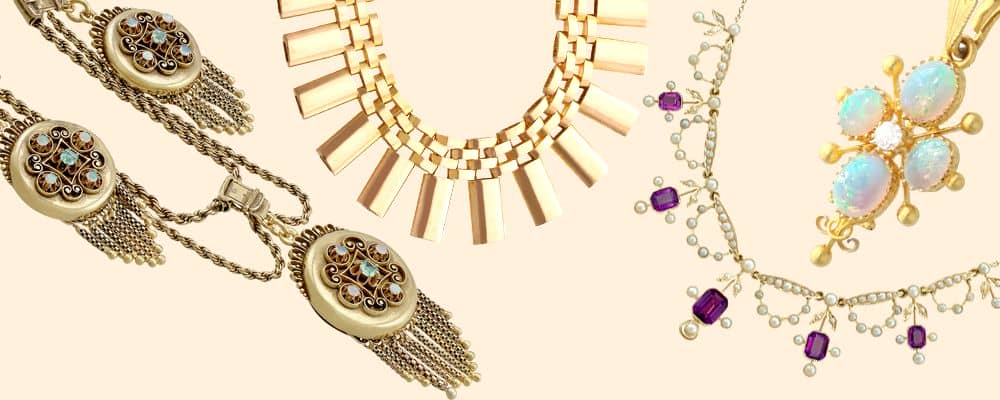Fringe Necklaces
Antique and Vintage Fringe Necklaces for Sale
Explore our fine collection of antique and vintage fringe necklaces for sale. Our collection includes gold fringe necklaces many adorned with diamonds and other gemstones.
All necklace purchases will arrive gift wrapped with a complementary insurance valuation and will include free global shipping.
Andrew Campbell, using his 40 years’ experience within the antique jewellery industry, handpicks all necklaces for sale.

Fringe Necklaces Frequently Asked Questions
A fringe necklace describes a series of pendant-like elements that cascade or hang from a traditional link or cord necklace. These dangling elements can be made from a variety of materials and can be uniform in length or graduated in size. As a result, fringe necklaces widely vary in form from luxurious gold to bright diamonds.
It is thought that the fringe necklace originates from ancient Egypt, based on historical artefacts that display the ‘wesekh’; a broad collar debuting in the 3rd millennium BC. However, fringe necklace styles were also discovered in archaeological excavations of the Greek Aegean islands, where it is thought the style was largely popular amongst ancient Minoan societies before the catastrophic volcanic eruption of Santorini.
Over time and through different cultures, the broad collar necklace developed with more elaborate pendants and wirework. Fringe necklaces were revived in the 19th century, influenced by the archaeological excavations of the time of ancient Egyptian tombs that spurred a revival in more ancient designs.
During both the Georgian and Victorian eras, ‘archaeological revival’ acted as the umbrella term for a major trend in which jewellery was recreated in the style of ancient jewellery, modelled after new discoveries found in excavations. Archaeological revival jewellery and especially fringe necklaces from this time period ate thought to be a direct result of new interest in Egyptian tomb excavations.
The 1920s saw a major change in fashion and jewellery, as it became the era of Art Deco. Fringe necklaces were characterised by geometric shapes that are so relevant to the Art Deco movement and were worn with the iconic flapper dress of the time. Necklaces cascaded with small beaded strands that created a similar fringed look to their dresses, and became a must-have for the ladies of the Roaring Twenties.
Once again, Egyptian curiosity influenced the jewellers of the 1920s, when the tomb of Tutankhamen, arguably the most well-known pharaoh of Ancient Egypt, was discovered in 1922. This discovery manifested itself in jewellery designs focusing on yellow gold, turquoise and Egyptian motifs once more. The fringe necklace was then somewhat reinvented in the 1950s with designers favouring simpler yet luxurious designs becoming the designs we see more commonly today.
The most famous fringe necklace is infamous City of London Fringe Necklace. One of Queen Elizabeth II’s treasured pieces, the diamond fringe necklace was received as a gift to honour her marriage in 1947. As a princess, the necklace was worn frequently leading up to the wedding day and more significantly worn for a series of portraits as Queen, paired with the Crown.
A noticeable feature of the necklace is the fact it bears resemblance to a number of tiaras. It is uncommonly known that a tiara can at times be transformed into a fringe necklace, similar to the Queen’s iconic City of London fringe. An example would be the Russian-inspired Kokoshnik tiara that was inherited in 1953 by Queen Elizabeth from Queen Mary. The diamond design of the tiara may be unscrewed from the supporting headpiece and transformed into a gorgeous fringe diamond necklace. The piece can then be reattached and becomes a tiara once more.
Crafted in the 19th century, the City of London necklace is a rare example of a fringe that cannot be converted to a tiara as it is threaded on silk rather then secured to a headpiece but is arguably one of the queens most loved pieces throughout her reign. The necklace has since been passed down to Queen Camilla, who wore the City of London fringe necklace paired with the Greville Tiara in attendance to the State Banquet during the state visit to Germany.












